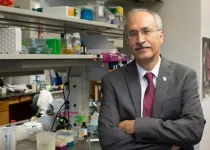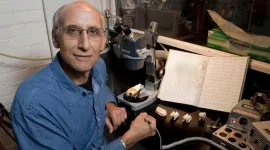(Press-News.org) Researchers at UNC Lineberger Comprehensive Cancer Center, after decades of research efforts, have developed a mouse model of Kaposi sarcoma that could be key to the development of new drugs to treat the disease. Kaposi sarcoma is a cancer that is the most common cancer in people living with HIV.
The findings appeared in Cell Host & Microbe.
“This is an important development as we have created the first animal model ever of Kaposi sarcoma. Animal models are essential to move new drugs from the laboratory bench into clinical trials,” said UNC Lineberger’s Dirk Dittmer, PhD, senior corresponding author, co-leader of the UNC Lineberger Virology Research Program and director of the UNC Viral Genomics Core. “Before this, only repurposed drugs from other cancers were used to treat Kaposi sarcoma, but now we can start investigating entirely new compounds to help treat what can be a lethal cancer.”
About 20% of all human cancers arise from viruses or require viral infection as an essential cofactor. The Kaposi sarcoma-associated herpes virus (KSHV) was discovered in 1994 and is associated with Kaposi’s sarcoma as well as B-cell cancers. KSHV-associated diseases affect internal organs and are ultimately fatal. In the U.S., the diseases are found primarily in immunosuppressed people such as those who are HIV-positive or are transplant patients.
Worldwide, an estimated 34,270 cases of Kaposi sarcoma were diagnosed, and 15,086 deaths reported in 2020, with twice as many cases and deaths occurring in men compared to women. Africa accounted for 73% of new cases and 86.6% of the deaths from Kaposi sarcoma worldwide. The disease is endemic, and not HIV-related, in some southern and eastern African countries.
Aside from animal models, one way to study cancer is to look at tumor cells in the lab. But according to Dittmer, Kaposi sarcoma tumor cells are very finicky and dependent on signaling molecules and blood supply, which is why they don’t survive in a laboratory culture dish. Therefore, researchers have been focusing on developing animal models that would mimic, as closely as possible, the disease in humans.
One of the challenges the researchers faced in developing their model was the fact that two types of genes are transcribed into proteins in the Kaposi sarcoma mouse model. Normally when a virus infects a cell, the cell dies as the virus replicates, which is a process called cell lysis; the genes that are needed for the virus to propagate itself are lytic genes. Cancer viruses are different as they enter a quiet state, called latency, where only the genes that help the infected cell survive are expressed. The mouse model the researchers developed is complex as a bit of both types of genes were needed.
Cervical cancer and its related virus, HPV (human papilloma virus), offers a good comparison for the challenge of developing a Kaposi sarcoma mouse model. The KSHV genome is 20 times larger than HPV. HPV has two cancer-causing genes, E6 and E7, so to mimic the disease in animals, researchers only needed to design two mice, one for each gene. KSHV may have as many as 10 cancer-causing genes that all work together so it would be way too difficult to develop that many mice, hence the virtue of their single model, Dittmer noted.
“Another of the key virtues of our new mouse model is that it helps us understand angiogenesis, or new blood vessel formation. Without angiogenesis cancer cells are deprived of oxygen and die,” Dittmer said. “In this mouse model, we can study angiogenesis blocking drugs better than ever before. If new drugs work against Kaposi sarcoma, they will also likely work against lesser-angiogenic tumors, which would be a major plus.”
For next steps, the researchers hope that others will pursue drug and vaccine development based on a new understanding of fundamental aspects of KSHV provided by their mouse model, including possible development of a much-needed primate model for human KSHV and Kaposi sarcoma.
END
Kaposi sarcoma discovery could facilitate drug development
2024-04-29
ELSE PRESS RELEASES FROM THIS DATE:
Research shows link between pollution and heart risks in residents of the city of São Paulo, Brazil
2024-04-29
The relationship between living in a polluted city like São Paulo (Brazil) and lung disease or cancer is well known. But the problems go further. Unprecedented research shows that long-term exposure to air pollution is directly linked to increased heart risks in residents of the capital of the state of the same name. People with high blood pressure are at even greater risk.
The study, published in the journal Environmental Research, was conducted by researchers from the University of São Paulo (USP) with support from FAPESP (projects 13/21728-2, 16/23129-7 and 19/06435-5). The research shows ...
Rice’s Yousif Shamoo elected AAAS fellow
2024-04-29
Rice University bioscientist Yousif Shamoo has been elected a fellow of the American Association for the Advancement of Science (AAAS), the world’s largest general scientific society and publisher of the journal Science.
The lifetime honor, one of the highest in the scientific community, is accorded to fewer than 1% of AAAS members each year. Shamoo, the Ralph and Dorothy Looney Professor in the Department of Biosciences, was recognized “for distinguished contributions to research on multidrug resistance, protein structure ...
Mazin to study electronic, transport & topological properties of frustrated magnets
2024-04-29
Igor Mazin, Professor of Practice for Advanced Studies in Theoretical Physics, Quantum Materials Center, Physics and Astronomy, is set to receive funding for the project: “Electronic, transport and topological properties of frustrated magnets.”
In this project, Mazin and his collaborators will examine frustrated magnetic systems.
Magnetic frustration lies at the core of the notion of skyrmions and quantum spin liquid.
Mazin will receive $258,480 from the National Science Foundation for this project. Funding will begin in May 2024 and will end in late April 2027.
###
ABOUT GEORGE MASON UNIVERSITY
George Mason University is Virginia’s largest ...
TCT 2024 Career Achievement Award to be presented to Robert A. Harrington, MD
2024-04-29
NEW YORK – April 25, 2024 – The TCT® 2024 Career Achievement Award will be presented to Robert A. Harrington, MD, during Transcatheter Cardiovascular Therapeutics® (TCT®), the annual scientific symposium of the Cardiovascular Research Foundation® (CRF®). TCT® will take place October 27-30 2024, in Washington, DC at the Walter E. Washington Convention Center. The award is given each year to an outstanding individual who has made extraordinary contributions to the field of interventional cardiology and has transformed ...
Tibetan plateau had broader social dimensions than previously thought
2024-04-29
The Tibetan plateau—the world’s highest and largest plateau—poses a challenge to the people who live there because of its extreme climate. In a new study, researchers have discovered stone artifacts that suggest that there were more cultural exchanges between those who lived on the plateau and those living on its perimeter.
“The Tibetan plateau has an average elevation of more than 4500 meters, which makes Colorado seem like it is at sea level. It’s amazing that people have been able to occupy this area on and off for at least the last 40,000 years,” said Stanley Ambrose (MME), a professor of anthropology. “Unfortunately, very little ...
Oncotarget sponsors 19th International p53 Workshop in Italy
2024-04-29
Oncotarget is a contributing sponsor at the 19th International p53 Workshop in Trieste, Italy, on May 13–16, 2024.
BUFFALO, NY- April 29, 2024 – Oncotarget is a contributing sponsor at the 19th International p53 Workshop, organized by the International Center for Genetic Engineering and Biotechnology (ICGEB), which takes place from May 13–16, 2024, in Trieste, Italy.
“Groundbreaking research and cutting-edge advancements in the field of the most studied human gene and most frequently mutated gene in cancer, will take center stage at the 19th ...
NYS solar work: Good for climate, but are they good jobs?
2024-04-29
ITHACA, N.Y. -- New York state solar construction workers – whose numbers are expected to grow rapidly to meet climate goals – are transient, may not receive benefits and are subject to racial disparities in pay, finds a new report from the Climate Jobs Institute (CJI) at Cornell University.
“Exploring the Conditions of the New York Solar Workforce” was funded by the New York State Department of Labor and surveyed more than 260 solar installation and maintenance workers. The exploratory study is the first to focus on workers’ experiences, seeking to bridge gaps in government and industry ...
New system boosts efficiency of quantum error correction
2024-04-29
The fragile qubits that make up quantum computers offer a powerful computational tool, yet also present a conundrum: How can engineers create practical, workable quantum systems out of bits that are so easily disturbed — and wiped of data — by tiny changes in their environment?
Engineers have long struggled with how to make quantum computers less error-prone, often by developing ways to detect and correct errors rather than prevent them in the first place. However, many such error-correction schemes involve duplicating information across hundreds or thousands of physical qubits at once, which quickly becomes hard to scale up in an efficient way.
Now, ...
Study suggests staying current with COVID-19 vaccinations helps combat emerging variants
2024-04-29
New research using live SARS-CoV-2 virus reveals an updated vaccine provides a strong immune response against previous strains and emerging variants.
The findings by researchers at Oregon Health & Science University, published in the journal Emerging Infectious Diseases, suggest a clear benefit in receiving updated vaccinations on a regular basis, especially among older people or those with underlying medical conditions.
“The virus is still circulating, it’s continuing to evolve, and it remains dangerous,” said co-senior author Fikadu Tafesse, Ph.D., associate professor of molecular ...
It’s all in the smile: Aston University-led research finds politicians can influence voters with facial expressions
2024-04-29
Dr Carl Senior identified two types of smile – affiliative and reward – given by political leaders during the last UK general election in 2019
The eventual winner, Boris Johnson, was found to display the affiliative smile, which acts to align voter behaviour
The study is the first to look at how supporters of election losers react to the eventual winner.
New research led by Aston University’s Dr Carl Senior has found that the type of smile used by a political leader can influence voters to support them and their political agenda.
There are many different types of smile, and the ...




